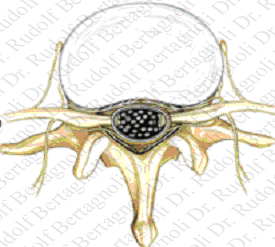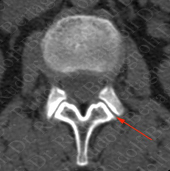Facet Hypertrophy
Facet Hypertrophy: Definition
Facet Hypertrophy is an enlargement of the facet joint. It can increase to the point where
nerves in the spine come under pressure and can cause lateral recess stenosis with subsequent radiculopathy. The hypertrophic degenerated joint is also a pain generator of its own.
 |
 |
|
Normal Facet Joints |
Right-sided Facet Hypertrophy |
 |
 |
|
Normal Facets in a CT |
Facet Hypertrophy in a CT |
The inferior articular process of a vertebra with the superior articular processes of the adjacent
lower vertebra forms a facet joint, also known as the zygapophysial joint. The facet joint is a synovial joint, as opposed to cartilaginous or fibrous joint. This means that the joint is
surrounded by a capsule, which is filled with lubricating fluid. The facet joint guides the flexion, extension and the rotation of the spine, while limiting motion in all directions to the appropriate degree.
Facet Hypertrophy: Most Often Treated
A Facet Hypertrophy most often occurs in people above the age of thirty.
Facet Hypertrophy: Causes
Osteoarthritis and overloading of the joint are the most common causes of facet hypertrophy.
The most common cause of overloading is degenerative disc disease, which causes the disc
height to shrink and consequently the bony components of the facet joint to place increasing pressure on each other. This type of pressure is also thought to increase the growth of
osteophytes in the facet joint.
Facet Hypertrophy: Symptoms
People with condition often adapt their posture to avoid pain, so they may walk hunch over, depending of the location in the spine of the condition. They often complain of stiffness and back pain.
Facet Hypertrophy: Diagnosis
Diagnosis of a Facet Hypertrophy is made by imaging. Confirmation of this pain generator can
be made by injection of a local anesthetic into the joint. If the patient experiences a
corresponding relief of pain, this is confirmation of painful Facet Hypertrophy. Correlation
between symptoms and imaging findings can conclude nerve entrapment by Facet Hypertrophy.
Facet Hypertrophy: Treatment (Conservative)
Conservative treatment is usually considered a temporary solution. The underlying condition is usually degenerative and will usually worsen in time. This is particularly true in the facet joint is overloaded due to disc height loss from degenerative disc disease.
- Steroid Injections
- Analgesic injections
- Anti-inflammatories
- Exercise
- Physical Therapy
- Braces
Facet Hypertrophy: Treatment Surgical Options
If pain is severe and continuous, or if there are neurological deficits, surgery may be
recommended. Surgical options include:
- In severe cases Facetectomy with Artificial Disc Replacement and
Dynamic Spine Stabilization (DSS) - Artificial Disc Replacement alone for mild to moderate cases with associated disc height loss
- Interspinous Process Decompression (IPD), aka Interlaminar Decompression (ILD)
- Percutaneous denervation (to quell nerve transmission of pain - no significant disc height loss)
- Cryogenic Denervation
- Rhizotomy
Note: These interventions only diminish the pain and do not deal with the underlying
problem. - Dynamic Spine Stabilization (DSS) to unload and realign the facets
- There is currently no proven facet resurfacing or replacement on the market.
Surgical goals include relief of nerve compression, allowing the nerve to recover, as well as
the relief of joint pain and restoration of normal function.
Facet Hypertrophy: Surgery Risks
All surgery carries risks from anesthesia, blood clots and infections. If complications from these risks arise, they most often can be successfully treated. The physical condition of the patient
(such as obesity and diabetes) can also add risk to surgery.
Facet Hypertrophy: Surgery Long-Term Outlook
The appropriate surgical procedure properly executed will provide long term relief for the
degenerated disc(s) treated. However, if the condition was allowed to continue too long and the nerves have become damaged, there may be some remaining pain or numbness or no
improvement. Also, any degenerative process will likely continue, therefore problems in
other areas of the spine may appear at a later time.
Facet Hypertrophy
